Thinking of adopting a Bourke’s parakeet? Good choice! These small pink parrots are a joy to have in the house with their calm personalities and soft, cheerful chirps. Despite their relatively easy care, though, it’s important to make sure you know what your parakeet needs to thrive.
Keep reading for everything you need to know about Bourke’s parakeet care and keeping your bird happy!
| Name(s) (common, scientific) | Bourke’s parrot, Bourke’s parakeet, rosy bourke parakeet, sundown parrot, blue-vented parrot, pink-bellied parrot, Neopsephotus bourkii, formerly Neophema bourkii |
| Natural habitat | Australia, nomadic, open woodlands |
| Adult size | Around 20 cm (8″), up to 50 grams (1.8 oz.) |
| Lifespan | 20+ years |
| Noise level | Very low (for a parrot) |
This post contains affiliate links. If you make a purchase, a small percentage will go directly to Psittacology at no additional cost to you. Thank you for supporting Psittacology!
Bourke’s parakeet appearance
The Bourke’s parakeet is not a large parrot: its maximum body length is around 20 cm or 8″ and even the plumpest males usually don’t weigh much more than 50 grams or 1.8 oz.
A wild-color Bourke’s is a smörgåsbord of color. Their backs are brownish with hints of green, but their bellies are a bright pink. The head is somewhere in between, while the wings feature a bright blue that’s only visible in flight.
Male vs. female Bourke’s parakeet
Figuring out whether a Bourke’s parakeet is male or female can be a challenge. The most accurate way is definitely to opt for a DNA test.
There are, however, some visual and behavioral indicators that can help you out:
- Males, as long as they are not a man-made color variety like lutino, will generally show a blue patch or band of feathers above the cere. This shows up only on mature birds. Some females will have a hint of blue as well, though males’ bands are more pronounced.
- Females are said to have a smaller head with darker coloration, though again, this is pretty vague.
- Male Bourke’s parakeets are real flirts. If you see yours pulling his wings back, strutting about and doing a bouncy dance, that is a reasonable indication that it’s a male.
- As with budgies, the males are the more vocal gender when it comes to Bourke’s parakeets. They’ll sing, while the females stick to just short tones.
Rosy Bourke’s parakeet
Sometimes spontaneous color mutations pop up in birds and other animals. With parrots like the Bourke’s parakeet, breeders often make quick use of these by establishing a stable line. Voilà, a brand new color is born!
With this species, a pink color mutation referred to as the rosy Bourke’s parakeet has actually taken over the original in popularity. It’s not difficult to see why: instead of sporting a brownish back for camouflage, the whole bird is bright pink. Only the wing tips retain a little dark coloration. This is also called opaline coloring.
Aside from the rosy Bourke’s parakeet, other popular mutations include:
- Rubino: pink with yellow wings and no brown at all
- Lutino: almost fully yellow with only hints of pink and no brown. Red eyes.
- Fallow: pink with pale brown
- Violet: like wild-type, but with more blue, partially mixed with pink
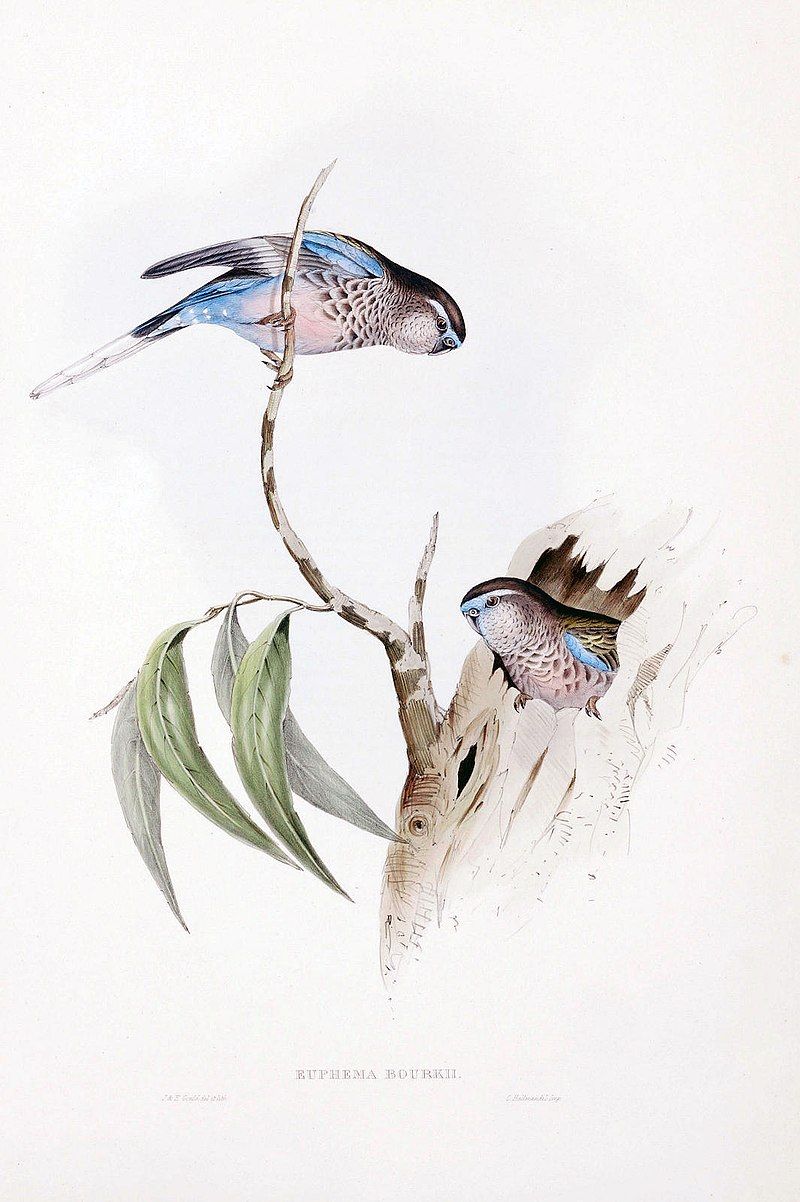
Bourke’s parakeet origin & natural habitat
Taking a peek at the wild habitat and lifestyle of our favorite parrot species can be pretty helpful in figuring out how to care for them in captivity, so let’s start off with that.
The Bourke’s parakeet naturally occurs in Australia.
Naming
Like many domestic parrots, including popular budgies and cockatiels, the Bourke’s parakeet originates from Australia. The species was first discovered in 1835 and later described in 1845.
Bourke’s parakeets were originally placed in a genus called Euphema and, later, long classified as grass parakeets of the genus Neophema. It was later found out that this is likely not what they are, as they can’t interbreed with other Neophema parrots. That’s why they’re now the only member of their own genus, Neopsephotus.
Nowadays, the species is commonly referred to as the Bourke’s parakeet. It’s also sometimes called sundown parrot or pink-bellied parakeet.
Did you know? Bourke’s parakeets were named for Sir Richard Bourke, who was a governor of New South Wales at the time. According to a 1927 article, he supported the expedition that ended up formally describing the species for the first time.
MacGillivray, 1927
Habitat
Like the popular budgie, the Bourke’s parakeet is totally adapted to surviving in Australia’s really harsh inland habitats. They’re nomadic, appearing throughout a huge (semi-)arid range while following food and water sources.
In their natural habitat, the Bourke’s parakeet can be found in anything from pairs to huge flocks. It spends a lot of its time foraging on the ground.
One interesting fact about this species is that it’s crepuscular. Unlike the majority of other parrot species, which go to sleep as soon as the sun sets, these are most active during dusk and dawn.
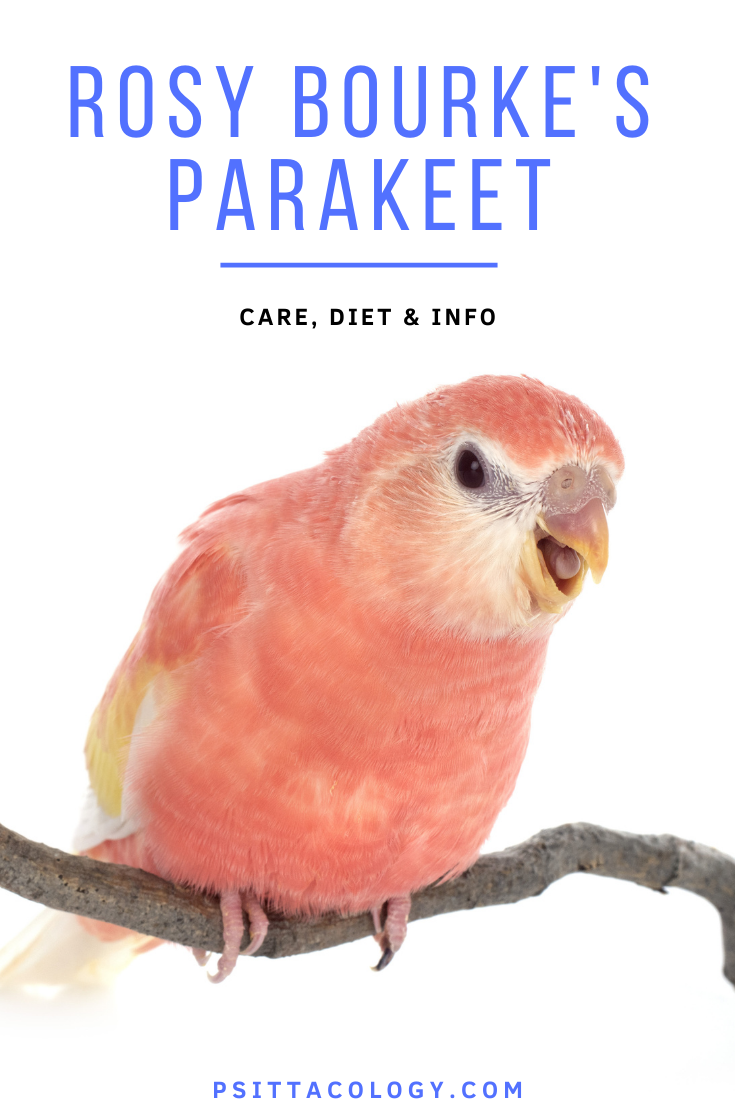
Bourke’s parakeet diet
Wild diet
In the wild, Bourke’s parakeets feed on seeds and grasses. They forage on the ground, which is said to be the reason for their lovely color and feather pattern: it helps them blend in.
Common vegetation in the species’ natural habitat are the mulga Acacia and spinifex (a type of grass), so it’s likely the seeds of these are included in their diet.
Domestic diet
The seeds these birds eat in the wild come from all sorts of different plant species and are eaten in different stages: unripe, ripe, dried, sprouted. They’ll also consume any other edible morsels they come across, like fruits or unlucky insects.
Veterinarians, like Psittacology’s own Dr. Daisy May, agree nowadays that a high-quality parrot pellet food is the healthiest for our domestic feathered friends. Although pellets look a bit boring, they’re formulated to contain everything a parrot needs without excessive fat.
This being said, you can also still supplement with (sprouted) seeds. Spice up a normal high-quality parakeet seed blend with things like chia seeds, different types of millets, and whatever else you can find. If you can find a non-polluted spot to pick them, wild grasses are a great option as well!
Lastly, you should offer plenty of fresh veggies, as well as occasional fresh fruit. You can find out which fresh produce is safe in the articles about vegetables for parakeets and fruits for parakeets.
Tip: You can find more information about figuring out what your parrot should be eating in the article on parrot diet. Malnutrition is a bit of an epidemic among pet parrots, so be sure to inform yourself!
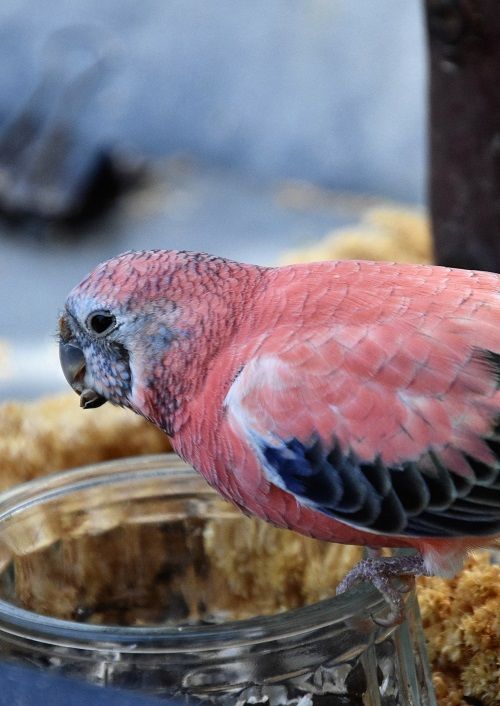
Bourke’s parakeet temperament
Their temperament is why most Bourke’s parakeet owners appreciate their birds so much. As far as parrots go, this is a sweet and calm species. They’re peaceful and maybe even a bit timid, perfect for apartments because they don’t tend to vocalize much.
You’ll see your Bourke’s parakeet just lounging around for much of the day, but that changes once the sun starts to set. Because they’re crepuscular, they’ll get a sudden burst of energy, which is pretty fun to watch.
If you keep your Bourke’s parakeet inside your home instead of in an aviary, you should be in for some pretty good company. This species is social and tame Bourke’s parakeets will usually love to hang out.
Bourke parakeet housing
It seems the Bourke’s parakeet is viewed mostly as an aviary bird, but that doesn’t mean you can’t have yours in a normal parrot cage in your house. If you want to do so, make sure to get a nice big flight cage, preferably a long one. They do love to fly around during their periods of activity.
In large aviaries, there are plenty of other bird species that you can house a Bourke’s parakeet with. They’re peaceful enough to leave pretty much everyone alone: society finches, grass parakeets, cockatiels, doves and more.
If you keep your Bourke’s parakeet inside in a cage rather than a full aviary, the best company is another Bourke. This is especially important if you don’t always have hours to spend with your bird every day.
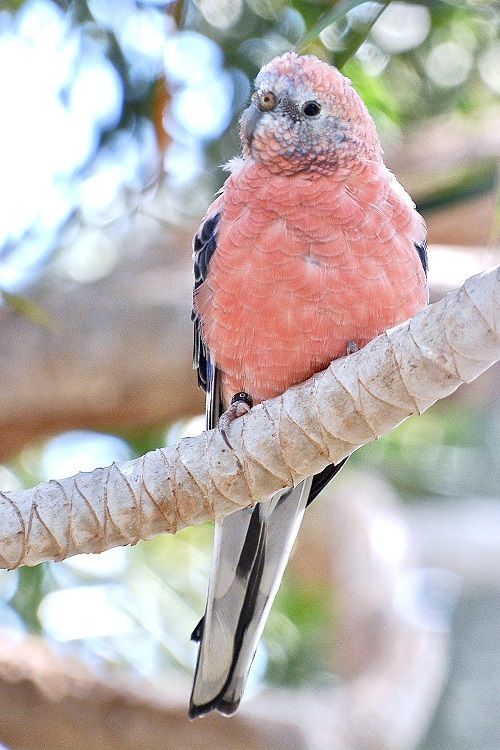
Bourke’s parakeet enrichment
The fact that Bourke’s parakeets love napping and lounging doesn’t mean you shouldn’t be providing yours with plenty of enrichment. Just like with other parrots, it’s important to keep their smart brains busy!
Here are some things you can do:
- Provide plenty of out-of-cage time. At least a few hours a day: these parakeets are great fliers and love to spread their wings.
- Provide lots of parrot toys. It doesn’t have to be fancy and a lot of toys can easily be DIY’d.
- Provide attention. Take your Bourke’s parakeet out of its cage for training or just to hang out together.
- Foraging. That’s what they naturally spend most of their time doing, so stimulate it! Offer foraging boxes, foraging toys and other options that encourage your Bourke’s parakeet to work for its food.
- Bath time. These parakeets love to bathe, so be sure to regularly provide a dish of water for yours to take a splash in.
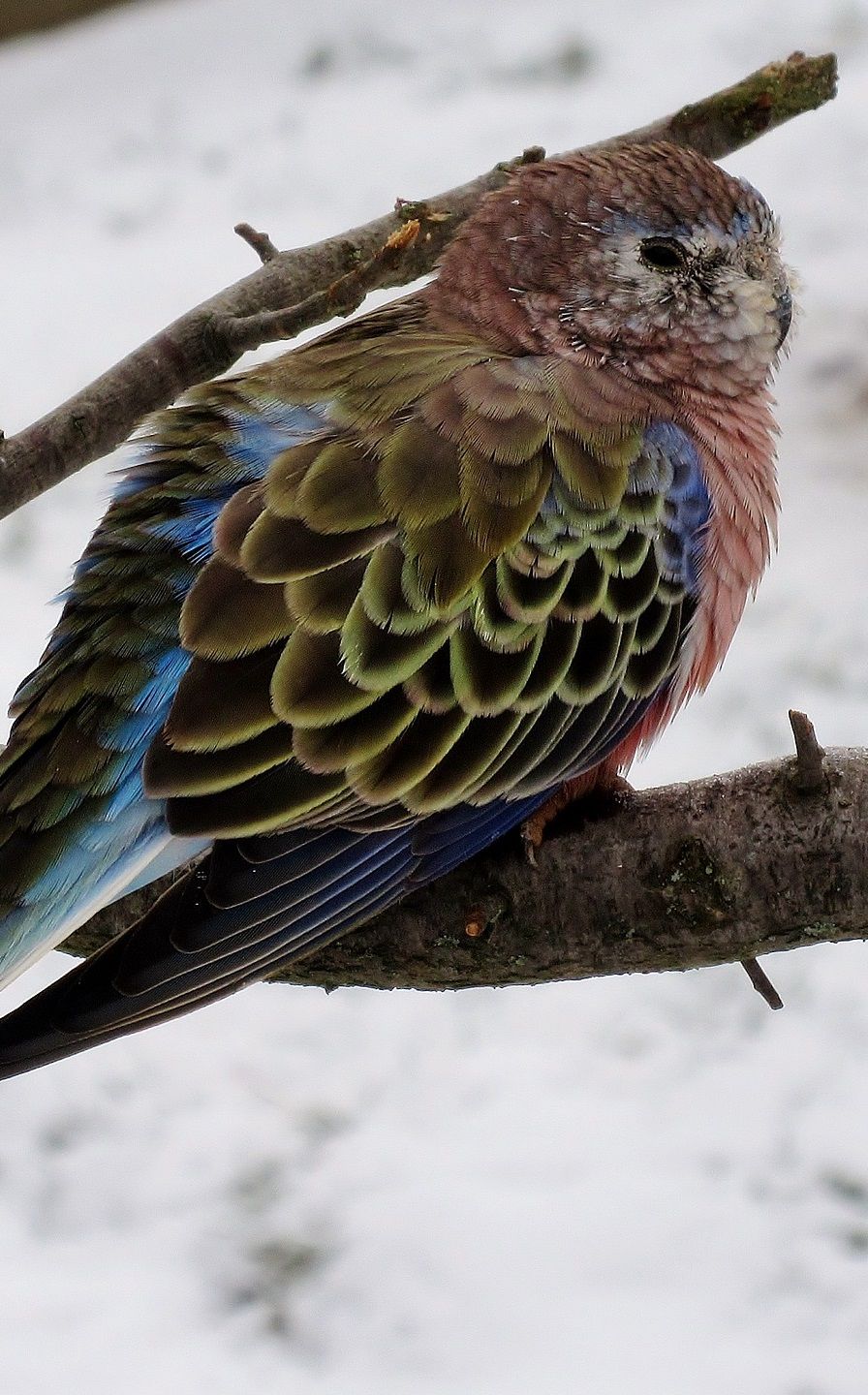
Bourke’s parakeet sounds
As mentioned earlier, Bourke’s parakeets are among the quieter parrots out there. No parrot will be silent, but the calls of a Bourke are unlikely to disturb neighbors.
The species becomes more vocal during their active hours of the day: dawn and dusk. Nothing to be too concerned about, though. Their chattering really is quite pleasant!
Do Bourke’s parakeets talk?
I have seen one or two videos of Bourke’s parakeets vaguely imitating human noises like speech and whistles.
That being said, this is not exactly the go-to species when it comes to talking.
Bourke’s parakeet medical issues
The Bourke’s parakeet is not a particularly vulnerable species. Like other parrots they tend to have an impressive lifespan and can live for over 20 years!
Keep an eye out for the usual suspects like psittacosis (which can spread to humans), respiratory infections and parasites (especially in outdoor aviaries).
You should always take new parrots to the vet for a check-up. It’s also important to know the basics of parrot safety and parrot emergency care.
Frequently asked questions
Although these parrots don’t like being manhandled, they can be cuddly. A well-socialized Bourke’s will likely love to hang out and nap on your shoulder!
If you have any more questions about Bourke’s parakeet care or if you want to share your own experiences with these delightful Australian parrots, don’t hesitate to leave a comment below.
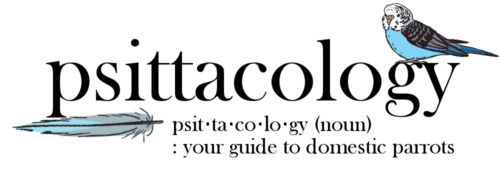
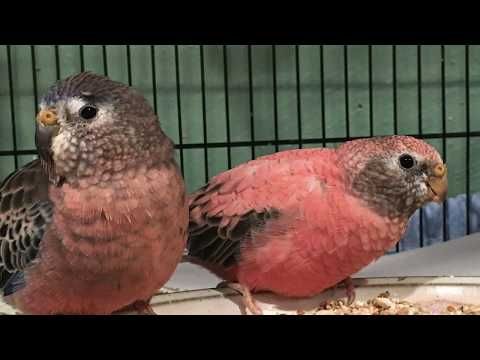
Just an observation – you keep referring to “rosy bourke” parakeets, which is kind of misleading in that people might not understand that the rosys are actually just a color mutation of bourke’s parakeets generally. I have a pair of the OG bourke’s and they are delightful birds and just as beautiful in their own way as those that have the newer color mutations.
I was thinking about this as well while I was writing the post, but a lot of people refer to them as rosies now, even the wild types, so I ended up publishing it like this. But you’re right. I changed it for clarity.
I agree that the wild types are lovely. So many colors!
Did Sir Bourke really “discovered” this species ?
I believe the Aborigines new long before him of this species.
Beste groete
Good point, I’ll change it to “described” 🙂
Hi, I’m so glad I found your site. I just bought two reset bourkes. Both females as that was all they had. One has a lot of black tips on a quite grey face. She is very squawky! The other is quite pink and was just starting to stand on my finger for 15sec but has started squawking imitating the others personality. I tempted them out of the cage once with a sprig of millet, but that was a disaster. They startled and flew into white walls of my apartment and one somehow fell behind couch. They haven’t been out since and are extremely hand shy. I live in apartment so can’t give them outdoor time. About to go from “flight cage” but not big, to biggest one on wheels I can find. These are the most nervous parakeets I’ve ever had! Ok so I wanted to know what stress lines look like and why Lady Greys head feathers almost look black tipped. They refuse to groom each other and only now started grooming their own tail feathers. But I cannot find images of unhealthy birds. I really feel the pinkest one would be tame by now if she wasn’t picking up the fear and get outta here response from lady grey. It’s kinda sad because I had such hopes to bond with these pretty and expensive lil girls. They won’t bathe so I mist them which just ticks them off. Can anyone tell me where to find images of unhealthy birds feathers? And how do I Safely give them out of cage time? Will they learn to go back in cage on their own? And how do I make them love me? (Yeah, I know how pitiful that sounds. I just know it was so much easier to bond with my normal parakeets decades ago.) can I add a quiet third bird of some sort that I might have better chance of bonding with so I can just be hands off with these girls?) thanks for listening. Btw I keep these on a table at window height in bedroom as I spend most of the time in here due to disability. So they have activity to watch all day. Ok thank you very much. Sus
Hey! Sounds like two gorgeous little ladies, sory you’re having trouble with them. The flying into the wall thing sticks out to me, I’ve had that happen and it really sucks. Based on what you’ve described, here’s what I would do:
– Let them practice flying for a few weeks in the larger cage you describe. It may help a bit.
– Start practicing letting them out. They will come back when they get hungry or thirsty, but it can be a while, so do this on a day you’re not planning on leaving. I’ve actually let mine stay out overnight when they were still practicing going back in, but this can be a little scary. Try making a fuss with their food container to lure them. Offer a little playground on top of the cage for them to hang out.
– Once they can go out without issues, start working on the tips described in the article on taming a parrot. I promise it works. My partner just did a little experiment the other day where he had our feral budgies flying to him within a DAY by training them with food!
As for Lady Grey’s appearance and the grooming issues, I would give them a bit more time. If she looks like the article cover photo, that’s ok, wild type Bourkes have more grey and it’s normal for a new bird to look a little scruffy at first. It can take a good while for birds to fully relax, they’re prey animals after all. You can add a third one, but I’d try working with these gals for a couple months before considering that personally.
Good luck! I know it’s frustrating when you were expecting something different, but with lots of attention, love and patience(!!!) I’m sure you can build a great bond with them. 🙂
Btw Lady Grey looks like the bird pictured above on your site. Rough looking. That caught me eye and fingers crossed maybe you can help me. She was a lot blacker at first so might be getting better, or maybe she was just young ? But looked looks like picture above. Is that normal? Healthy appetite of millet and sprouts but won’t touch carrot or broccoli ok thanks again
We’ve had a rainbow wing rosa bourke for over eleven years, and he’s been such a sweet family pet. I would say he’s MUCH more vocal than described in the article. He mocks a lot of words and sounds; he’ll say his name, “Cheerio” and “good birdie”, cat call (whoot woo), mock people’s laughter, and among other things, he even sings (in pitch) parts of the theme song to the Andy Griffith Show. Is this not normal? He’s been such a fun bird, and part of that is how he enjoys mimicking sounds and interacting with us.
Hey! That’s awesome, thanks for sharing 🙂 it’s really varied, but many report their Bourkes being rather quiet, although they do have the capacity to mimic speech and sounds. If you have any videos, be sure to drop a link! I’d love to see.